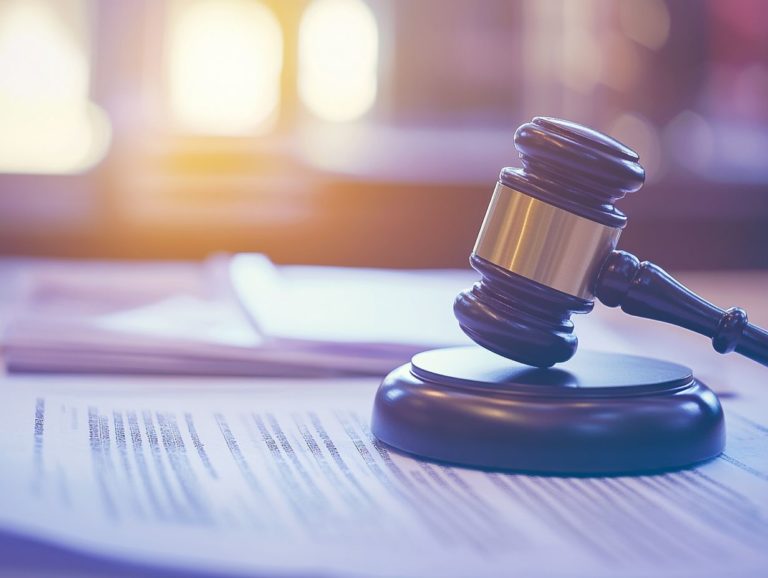Litigating Trade Secrets: Challenges and Strategies
In today s fiercely competitive business landscape, safeguarding your trade secrets is more critical than ever. This article delves into what trade secrets are and why they matter, shedding light on the complexities that arise during litigation when these secrets are compromised.
Proving misappropriation and protecting confidential information can present daunting challenges. You ll find valuable insights into effective strategies for successful litigation and preventative measures that ensure your intellectual property stays secure.
Together, you will explore the intricacies of trade secret litigation, arming yourself with the knowledge you need to navigate this complex field.
Contents
- Key Takeaways:
- Understanding Trade Secrets
- Challenges in Litigating Trade Secrets
- Strategies for Successful Litigation
- Alternative Dispute Resolution Options
- Preventing Trade Secret Litigation
- Best Practices for Protecting Trade Secrets
- Non-Disclosure Agreements and Other Preventative Measures
- Frequently Asked Questions
- What are some common challenges faced when litigating trade secrets?
- What is the definition of a trade secret?
- Is it possible to avoid litigation and protect trade secrets?
- What are some strategies for successfully litigating trade secrets?
- What is the statute of limitations for trade secret litigation?
- Can I recover damages in a trade secret litigation?
Key Takeaways:

Litigating trade secrets can be challenging due to the difficulty in proving misappropriation and protecting confidential information during litigation. Successful strategies for litigation include gathering and presenting strong evidence, understanding the trade secret litigation process, and considering alternative dispute resolution options. To prevent trade secret litigation, it is crucial to implement best practices for protecting trade secrets and utilize tools such as non-disclosure agreements.
Understanding Trade Secrets
Understanding trade secrets is essential for anyone managing confidential information. These secrets are a cornerstone of intellectual property and offer a significant competitive edge in sectors like information technology and healthcare.
Trade secrets include proprietary information that organizations work diligently to safeguard from theft and economic espionage, which refers to the illegal acquisition of trade secrets.
Therefore, you must understand the legal frameworks, including the Economic Espionage Act, that underpin these protections and the responsibilities that come with maintaining confidentiality.
Defining Trade Secrets and Their Importance
Trade secrets encompass formulas, practices, processes, or any information that gives your business a competitive advantage while remaining confidential. Legal protections through various statutes ensure your information is safeguarded.
Take Coca-Cola’s legendary recipe as an example. This closely guarded secret has been vital to its success for over a century. If this exclusive formula were disclosed, it could dramatically alter the competitive landscape.
Legal protections like the Uniform Trade Secrets Act provide robust avenues for defending against theft and misuse. Confidentiality clauses in employee contracts also provide protection by preventing unauthorized sharing that might jeopardize your market position.
By adopting a comprehensive strategy for safeguarding trade secrets, you protect your innovations and reinforce your competitive integrity in the marketplace.
Challenges in Litigating Trade Secrets
Litigating trade secrets presents significant challenges. Understanding trade secret litigation is crucial, as the process demands navigating complex legal landscapes, including misappropriation claims, along with the looming threat of high litigation costs and attorney fees.
You must understand your options in civil courts for trade secret holders.
Difficulty in Proving Misappropriation
Proving misappropriation in trade secret cases is challenging. You need clear evidence to show that someone illegally obtained or shared your confidential information. This process requires meticulous preservation of information.
Several factors complicate this process, including the often-hidden nature of misappropriation and the need for rigorous evidence preservation protocols. Without proper documentation and data retention policies, gathering sufficient proof can quickly become a daunting task.
Act now to conduct internal audits or bolster your security measures to protect sensitive materials. Understanding these strategies can significantly assist you in navigating the complexities of legal proceedings surrounding misappropriation claims.
Protecting Confidential Information During Litigation

Protecting your confidential information during litigation is essential if you’re a trade secret holder. It requires implementing robust protective measures, such as injunctions, while following common practices to ensure your sensitive information remains secure throughout the legal process.
It s crucial to engage in proactive planning. Establishing clear confidentiality agreements and non-disclosure policies defines expectations and responsibilities.
Utilizing digital security tools and conducting thorough audits can further bolster the security of your sensitive data. As litigation unfolds, requesting protective orders can significantly reduce the risks of inadvertently disclosing trade secrets.
Your legal counsel must know the relevant state and federal laws governing confidentiality. This knowledge enables you to navigate complex issues effectively and demonstrates your commitment to protecting your proprietary information.
Strategies for Successful Litigation
Employing effective strategies for successful litigation is crucial for you as a trade secret holder seeking to enforce your rights. This involves gathering evidence meticulously, understanding the litigation process, and navigating international trade secrets law to explore alternative dispute resolution options.
By doing so, you can mitigate costs and expedite outcomes, ensuring your interests are well-protected.
Gathering and Presenting Evidence
Gathering and presenting evidence is vital in the litigation process. As a trade secret holder, you must document and analyze information to convincingly establish your claims in court.
This diligent process bolsters the credibility of your claims and assists legal professionals in crafting a compelling narrative that justifies the protection of your proprietary information.
Best practices for documentation include:
- Maintaining a clear chain of custody
- Ensuring the authenticity of records
- Employing secure methods for storing sensitive data
Your legal analysis relies heavily on how well the evidence is curated. The strength of your protection against misappropriation of trade secrets often hinges on the clarity and comprehensiveness of the evidence presented.
Understanding these elements can significantly influence the outcome of litigation, ensuring your rights as a trade secret holder are effectively safeguarded.
Protecting Trade Secrets During Litigation
During litigation, protecting your trade secrets is vital. You must adhere to confidentiality obligations and implement protective measures to ensure sensitive information remains shielded from unauthorized parties.
To safeguard your proprietary information, familiarize yourself with the legal framework governing trade secrets, including relevant statutes and case law that outline your responsibilities.
Utilizing protective orders legal documents that limit access to sensitive information during litigation becomes a crucial step. These orders restrict access to confidential materials solely to those directly involved in the litigation.
Establishing stringent internal protocols for handling sensitive documents is another key strategy for preserving confidentiality. Train your employees on the importance of trade secret protection and ensure proper safeguards are in place when sharing information, even within the legal context.
Alternative Dispute Resolution Options
Exploring alternative dispute resolution options is a savvy strategy in trade secret litigation. It allows you to resolve conflicts through mediation or arbitration, saving time and money compared to traditional legal proceedings.
Mediation is a process where a neutral third party helps both sides reach an agreement. Arbitration, on the other hand, provides a binding decision that often resolves issues faster than court proceedings.
By integrating these methods into your legal strategy, you can reduce the risks of lengthy litigation. This also helps maintain valuable relationships that could suffer in a contentious courtroom setting.
The confidentiality of these processes protects your sensitive information. This makes alternative dispute resolution appealing for companies concerned about safeguarding trade secrets.
Preventing Trade Secret Litigation

Preventing trade secret litigation is an essential proactive strategy. By implementing best practices in trade secret management such as using non-disclosure agreements and ensuring compliance with relevant legal requirements you can effectively safeguard your proprietary information.
This approach minimizes the risk of legal disputes and fortifies your business s competitive advantage in the marketplace.
Best Practices for Protecting Trade Secrets
Adopting best practices to protect trade secrets is crucial for maintaining your organization’s competitive edge. This involves implementing strong confidentiality obligations and developing comprehensive business strategies that highlight the importance of trade secret protection.
To get started, identify your valuable confidential information. Establish clear policies outlining who can access this data and under what circumstances.
Regular training for employees on these protocols reinforces a culture of awareness and responsibility. Incorporating technological solutions like encryption adds an additional layer of security.
By integrating these practices, you safeguard your intellectual assets and align with your organization’s long-term goals. This keeps everyone informed and focused on protecting your valuable information.
Non-Disclosure Agreements and Other Preventative Measures
Non-disclosure agreements (NDAs) are crucial in preventing trade secret litigation. They act as legal safeguards, ensuring that anyone handling confidential information is bound to protect it from unauthorized disclosure.
These agreements clearly define what qualifies as confidential information and outline the penalties for any breaches. For example, a company may require employees to sign an NDA before discussing proprietary data related to product development, which helps keep their innovations safe.
NDAs can be customized to include specific clauses that inform all parties of their responsibilities. This fosters a culture of confidentiality throughout the organization.
By implementing these preventative measures, you protect your intellectual assets and enhance your credibility in the market. NDAs become an essential tool in building a strong framework for trade secret management.
Frequently Asked Questions
What are some common challenges faced when litigating trade secrets?
Some common challenges faced when litigating trade secrets include proving the existence of a trade secret, maintaining its secrecy during the litigation process, and identifying all potential defendants who may have misappropriated the trade secret as outlined in trade secrets in the digital age: challenges.
What is the definition of a trade secret?

A trade secret is confidential information that gives a business a competitive advantage, is not generally known or easily accessible by the public, and is subject to reasonable efforts to maintain its secrecy.
Is it possible to avoid litigation and protect trade secrets?
Yes, you can avoid litigation by taking steps to protect your trade secrets. Use confidentiality agreements, limit access to sensitive information, and enforce strict security measures.
What are some strategies for successfully litigating trade secrets?
To successfully litigate trade secrets, conduct a thorough investigation. Document everything and gather solid evidence to prove that your trade secret has been misused.
What is the statute of limitations for trade secret litigation?
The time limit for filing trade secret lawsuits varies by state, usually between three to six years. Consulting with a lawyer who understands local trade secret laws is crucial.
Can I recover damages in a trade secret litigation?
If you prove that your trade secret was taken without permission, you can recover damages. This may include lost profits, royalties, attorney fees, and court costs. You might also obtain a court order to stop further misuse of your trade secret.






